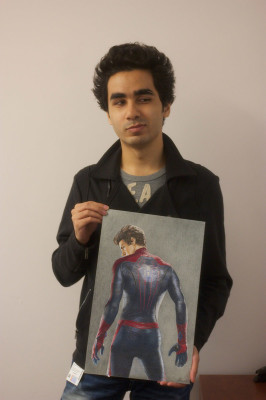Accessible Learning office works to shed stigma

Mansoor Naderi holds up one of his drawings. The third-year Visual and Creative Arts student registered with the Accessible Learning office in his second year.
STORY AND PHOTO BY TAYLOR SHAPPERT
The Accessible Learning office at Sheridan helps about one in 10 students, yet many students with special needs don’t come forward for help.
Mansoor Naderi is a third-year Visual and Creative Arts student with retinopathy of prematurity, a condition that means “I have no light perception out of my right eye, (and) less than 5 per cent vision out of my left,” he said.
He was aware that Sheridan has an Accessible Learning office which offers accommodations for students with disabilities, but he didn’t use the office until the middle of last year, “because I was stubborn and I wanted to fit in and I wanted to be normal… as time went on, I started to come here, to the Student Advisement centre. I love the people here. They welcome me every day. They always seem happy to see me.”
The office gave him accommodations like “extensions on tests and stuff, because I got one eye compensating for two so it takes a longer time for me to do stuff. I do my tests here (in the Accessible Learning office). I take breaks as well. dI also use the extended time on assignments,” he said.
“I enjoy being around here; the company, the fact that they talk to you. They’re real, they’re not just someone standing behind a desk,” he said.
Acting manager of the office Matt Rempel and learning strategist Janice Galloway are trying to remove the stigma surrounding disability so students aren’t afraid to ask for help.
“Accommodations are a way to reduce or eliminate any disadvantages that might be a result of a disability. The idea is not to make it academically easier. It’s about promoting their ability to achieve. It’s also about creating an equal playing field so every student has that access to success.” Rempel said.
“And to be fair to that student. And working with their strengths; as a learning strategist that’s what I do. I use the student’s strength to help them with the learning challenges that they’re having,” Galloway added.
Students should bring in their individual education plan (IEP), or psycho-educational assessment to receive accommodations. “They need documents to prove they have a diagnosed disability, so this could be in the form of an IEP which is an individual education plan, but we prefer a psychological educational assessment or other medical documentation,” said Galloway.
Accommodations could be in the form of extended time on tests and assignments, use of assistive technology and software, note taking support, short breaks from class or others that would best accommodate a student for their success. “We also would prefer if the documents are within five years because if it’s out of date we need to do a reassessment because things can change over time.”




